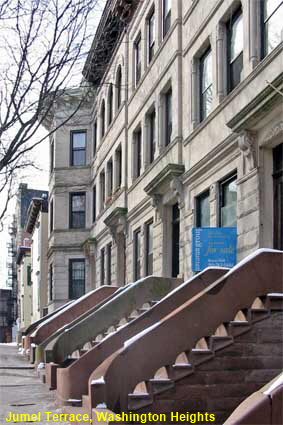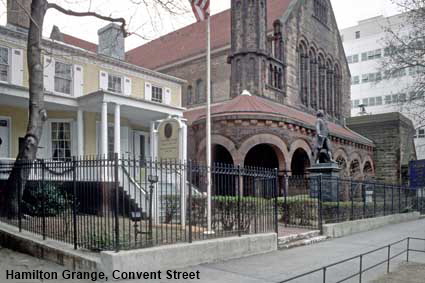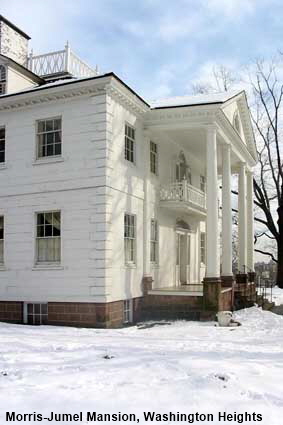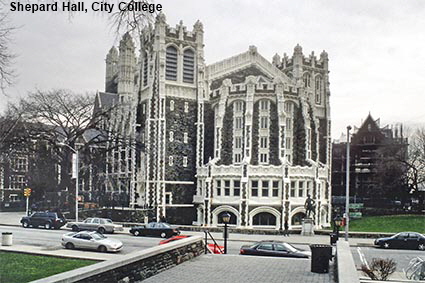Uptown Manhattan
Technically Uptown is anywhere on Manhattan Island north of Midtown, but we are using the term to cover just the three districts in the extreme north of the island, Morningside Heights to the west, Washington Heights in the very north and Harlem to the east. Not that we have much material on Harlem. Even though the years of zero tolerance policing have improved its fearsome reputation, we have yet to explore the area in any depth. Although only a subway ride away from bustling Midtown, life in the north of the island seems more detached from the rest of the city. It is up here that you find some major educational establishments, some significant historical gems and a lovely park overlooking the Hudson River.
Hamilton Grange, Convent Street
At 287 Convent Avenue a house appears to have been hemmed in by a church, yet it was use as a temporary church that saved the house from demolition. This was the home for the last 2 years of his life of Alexander Hamilton, who was instrumental in creating the US Constitution and the first Secretary of the Treasury. He is also now the subject of a very successful Broadway musical. Hamilton died in 1804 from wounds incurred a duel with his political rival Aaron Burr. Hamilton Grange is now preserved as a National Memorial.
Morris-Jumel Mansion
Standing on a hilltop in Washington Heights is Manhattan’s oldest house, the Morris-Jumel Mansion dating from 1765. It was built on an estate of 52 hectares (130 acres) by British Colonel Roger Morris as a summer home for his family. The Revolutionary War forced Morris to return to Britain and in 1776 the house was briefly used as headquarters by General Washington. After the Revolutionary War the mansion was confiscated by the US government and turned into a tavern. It was bought by French Merchant Stephen Jumel in 1810 who converted it back into a house. The house remained in the Jumel family until his wife died in 1865. In 1903 New York City bought the house and it was turned into a museum. Click Tab 2 to see a picture of the Dining Room.
Grant's Tomb & Riverside Church from Hudson River
Ulysses S. Grant, the victorious Union commander of the Civil War and 18th President of the USA, spent his later years living in New York. Following his death in 1885 donations flooded in to build a mausoleum. Grant’s Tomb was completed in 1897 and both Grant and his wife are buried there. Although the circular building on the left looks small in the picture it is the largest mausoleum in North America. To the right, the prominent tower of the Riverside Church that opened in 1929.
Low Memorial Library & St Paul's Chapel, Columbia University
Ask anyone to name an Ivy League university and the chances are that they will say Harvard, Yale or Princeton. Up in Morningside Heights New York has its own Ivy League university, Columbia. Founded as King’s College in 1754, it was originally sited near Wall Street in Lower Manhattan. The name was changed to Columbia College in 1784 to reflect the post revolutionary era. After several moves northwards, Columbia University arrived in Morningside Heights in in 1897. The Low Memorial Library show here was one of the first buildings on the site, but has not been used as a library since 1934. In addition to the Morningside Heights campus the university has a Medical Center in Washington Heights.
Town houses in Jumel Terrace, Washington Heights
Traditionally New York has been represented in the movies by town houses their trade mark flight of steps up to the front door. Indeed we saw them in the back lot at Universal Studios in California. When we first visited New York we were disappointed because we couldn’t find any. New York has lost a lot of its historic buildings to modern development - even the magnificent Grand Central Station was once under threat. Some of the historic buildings that have survived find themselves hemmed in by modern buildings. Town houses still exist, but you have to go out of the centre to find them.
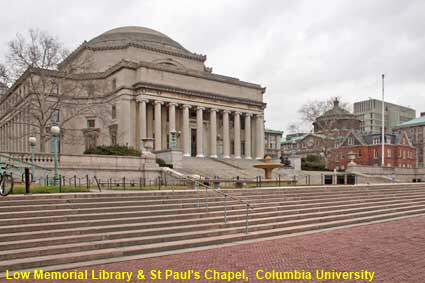
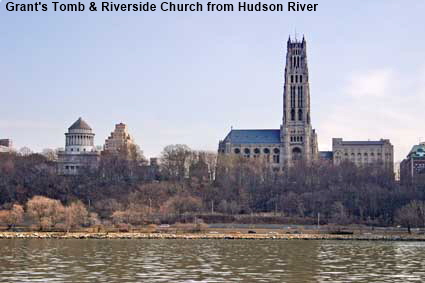
Shepard Hall, City College NY
The City College of New York was founded in 1847 as The Free Academy of the City of New York. It was founded to provide higher education for bright young men from working class and immigrant families who could not afford private college. Although education here is no longer free, it is provided at low cost. The college boasts eight Nobel laureates amongst its alumni. The building in this picture that looks like a gothic church is actually a college building called Shepard Hall, built in 1907.
Click on Minimap to navigate
DLU060301


To move forwards or backwards through the Manhattan trail click the arrows above, or select your next destination on the Minimap.
Azaleas, Heather Garden, Fort Tryon Park
Situated nearly as far north as you can get in Manhattan is a delightful 27 hectare (67 acre) park. Fort Washington was the Continental Army’s last stronghold in Manhattan which the British took in November 1776. The fort had a northern outpost and the British named the outpost Fort Tryon after Sir William Tryon, the Governor of the Province of New York. After the Revolutionary War the site of the outpost became part of a country estate. In 1917 John D. Rockefeller, Junior acquired the estate plus other land to the north. In 1927 he engaged the Olmsted Brothers Firm to design a park on the land where Fort Tryon once stood which he would donate to New York City. The land that he chose stands high above the Hudson River and Rockefeller also bought the land opposite it on the New Jersey side to prevent it from being developed. Fort Tryon Park was built during the Great Depression, providing much needed jobs and it was completed in 1935.
Cuxa Cloister, Cloisters Museum
In 1925 John D. Rockefeller, Junior acquired a collection of Medieval European architectural fragments owned by American sculptor George Grey Barnard. Rockefeller extended the collection with pieces of sculpture and decorative arts from the same period. In 1931 he decided that Fort Tryon Park should include a museum to house the collection. The museum was based around four cloisters from abandoned French monasteries and abbeys; Cuxa, Bonnefont, Trie and Saint-Guilhem. Between 1934 and 1939 the cloisters were excavated, carefully taken apart and rebuilt at the new museum. The Cuxa Cloister came from the Benedictine monastery of Saint-Michel-de-Cuxa, in the north east French Pyrenees. Founded in 878, the monastery was abandoned in 1791. In 1906 George Barnard purchased the ruins and moved around half of remains of the monastery to New York. The stonework recovered from the monastery has been used to reconstruct a twelfth century cloister at the museum complete with a garden and stone walkways. The museum also has a thirteenth century Gothic Chapel complete with 13th/14th century tombs and stained glass windows from the church of Saint Leonhard in Carinthia and the castle chapel at Ebreichsdorf near Vienna. The Cloisters Museum is now known as the Met Cloisters, part of the Metropolitan Museum of Art whose main museum is now known as the Met Fifth Avenue. Entry is by donation and you can use the same donation to enter both sites on the same day. Click Tab 2 to see the Gothic Chapel or Tab 3 to see an item of artwork from the museum, The Lamentation dating from 1480
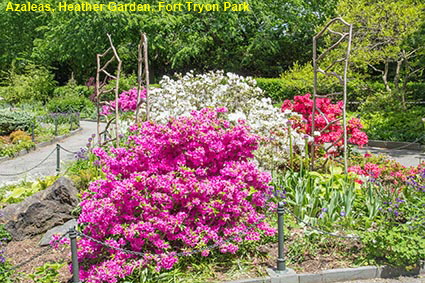
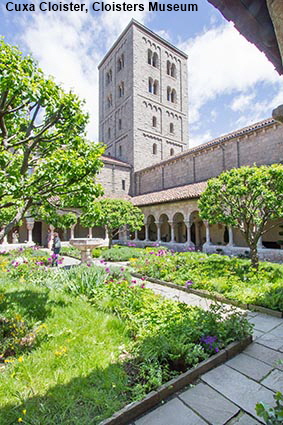
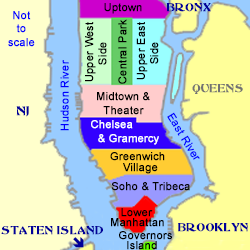

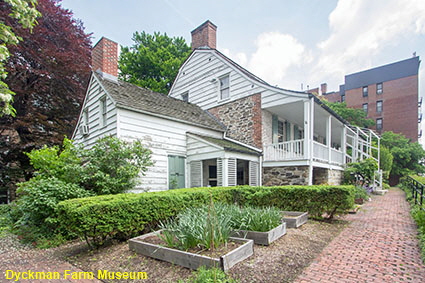
Dyckman Farm Museum
In the very north of the island is a house with strong connections to the days when the Dutch ruled this area. Jan Dyckman arrived from Westphalia, Germany in 1661, three years before the end of Dutch rule. He built up a farm of more than 100 hectares (250 acres) in the north of Manhattan island. His family grew to nine children and 25 grandchildren which required several houses. Around 1785, just after the end of British rule, his grandson William Dyckman needed to replace a house destroyed during the Revolutionary War. He built the Dutch Colonial style farm house that you see in this picture. The Dyckman family owned the house until 1868 but by the time the 20th century arrived it was dilapidated and under threat of demolition, so in 1915 the Dyckman family bought it back. Sisters Mary Dyckman Dean and Fannie Dyckman Welch restored the house and in 1916 they gave the house with original Dyckman furnishings to the City of New York for use as a museum of Dutch and Colonial life. The Dyckman Farm Museum is the oldest building in Manhattan and it still stands on its original site. For more than 200 years this building has kept watch over the changing face of Manhattan; buildings have sprung up on the former farm land and Broadway was built on a lower level right in front of it. The museum is open Thursday to Sunday each week. Click Tab 2 to see a picture of the parlor in the farm house.
© Mike Elsden 1981 - 2025
The contents of this page may not be reproduced in full or in part without permission
